
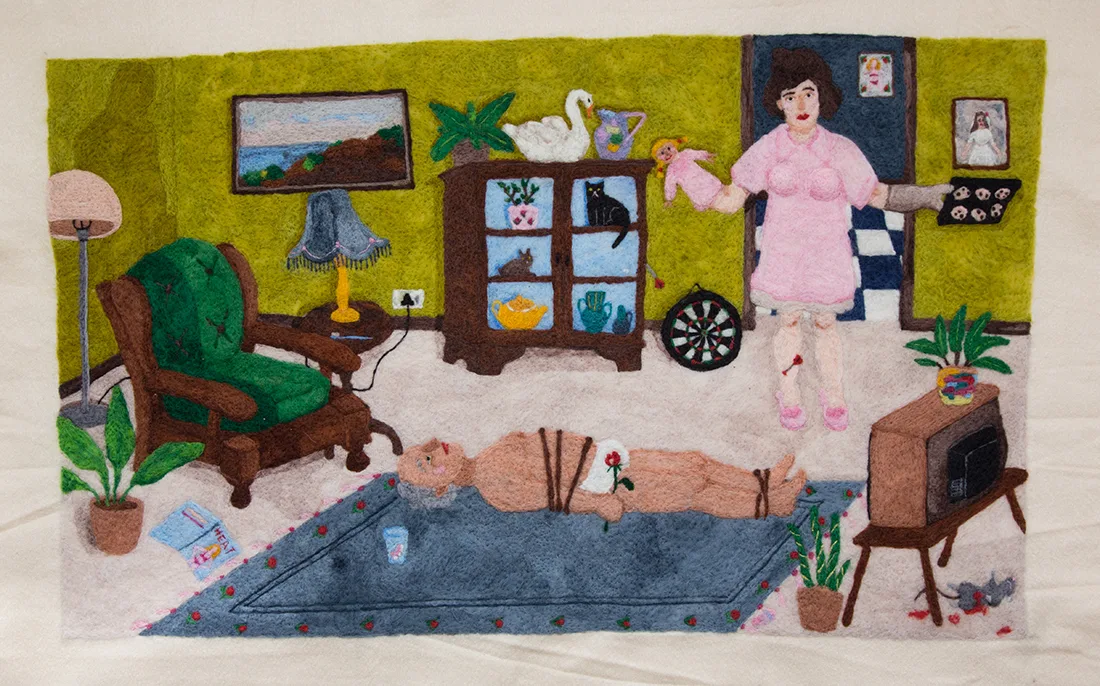
The tiny tableaux Michaela Younge stitches are weird, to say the least. When you first see one of her felt tapestries, nothing seems to make a whole lot of sense, and it’s hard to put any detail into words. Who better, then, to shed light on the surreal scenes than Michaela herself, as she describes to Alex Kahl every detail in some of her favorite works.
As a child, Michaela Younge would spend time making entire towns out of paper. “I’d recreate the façades of buildings on each page, and eventually it would take up most of my wall,” she says. “There were shops, apartments and even a theater.” Theaters were prevalent in her non-paper life too, and she recalls being blown away when a bird marionette was shot down from the sky and feathers exploded across the stage. These two memories stand out for her on her journey towards the surreal wool scenes she stitches today. “In my work now, I am still inspired by the city, and by imagining my figures occupying a fake space like actors in front of a backdrop in a play,” she says.
If we do see each of Michaela’s tableaux as scenes from plays, then these are some very strange plays. It’s hard to know where to look as your eyes are drawn to every corner of the frame. “There’s definitely an element of the Shakespearean ‘comedy of errors’ in my work, with loads of ridiculous events unfolding simultaneously,” she says. A skeleton sits as a contestant on a dating show, a rooster is arrested in a strip club, and many characters seem to have recently lost a limb.
I think people have inherently violent sides to them that they mostly keep locked away.
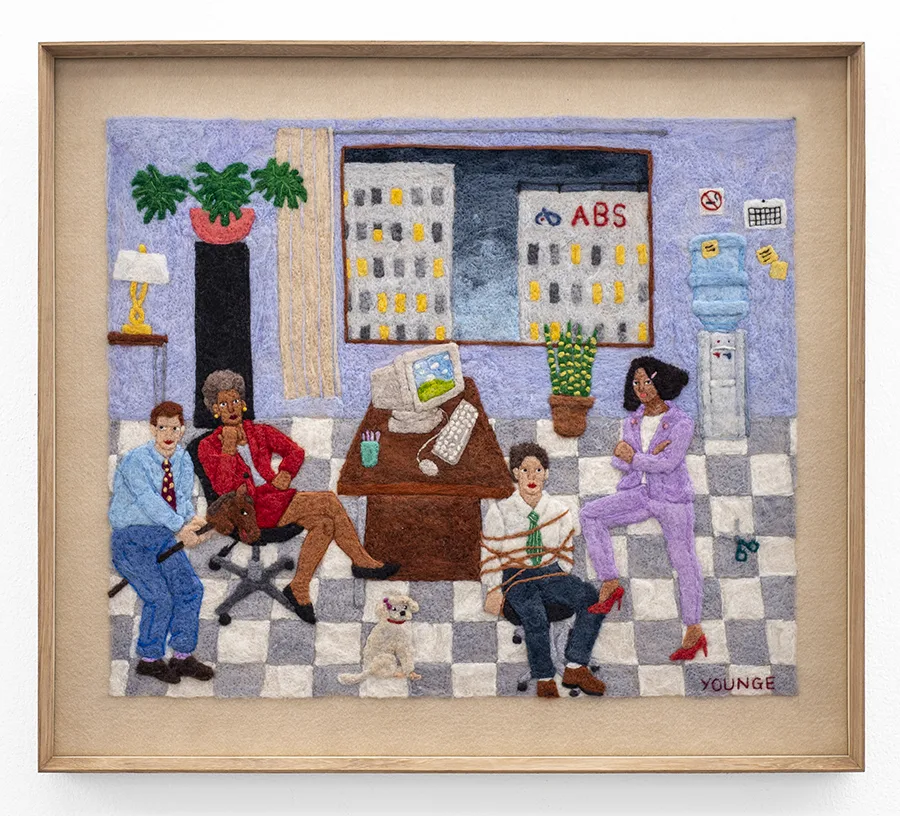

Michaela takes her inspiration from anywhere and everywhere – from overheard conversations to her own dreams. She’ll start each work with a backdrop, before adding the more minute details piece by piece. “I spend a lot of time on the details, and that’s often the most time-consuming part,” she says. “With the larger expanses of color, the repetitive stabbing of the wool can become somewhat meditative.”
The word “stabbing” is an apt reminder of the little violences prevalent in so many of her pieces. She’s always loved the idea of “cautionary tales,” those stories that are passed down through generations to teach people a lesson by showing them the consequences of mistakes. If you look closely, you can spot these teachings throughout her work, albeit teachings on the more eccentric side: “Don’t drive your car through the window of a grocery store” or “don’t try to sell a house when there’s a severely injured dog in it.”
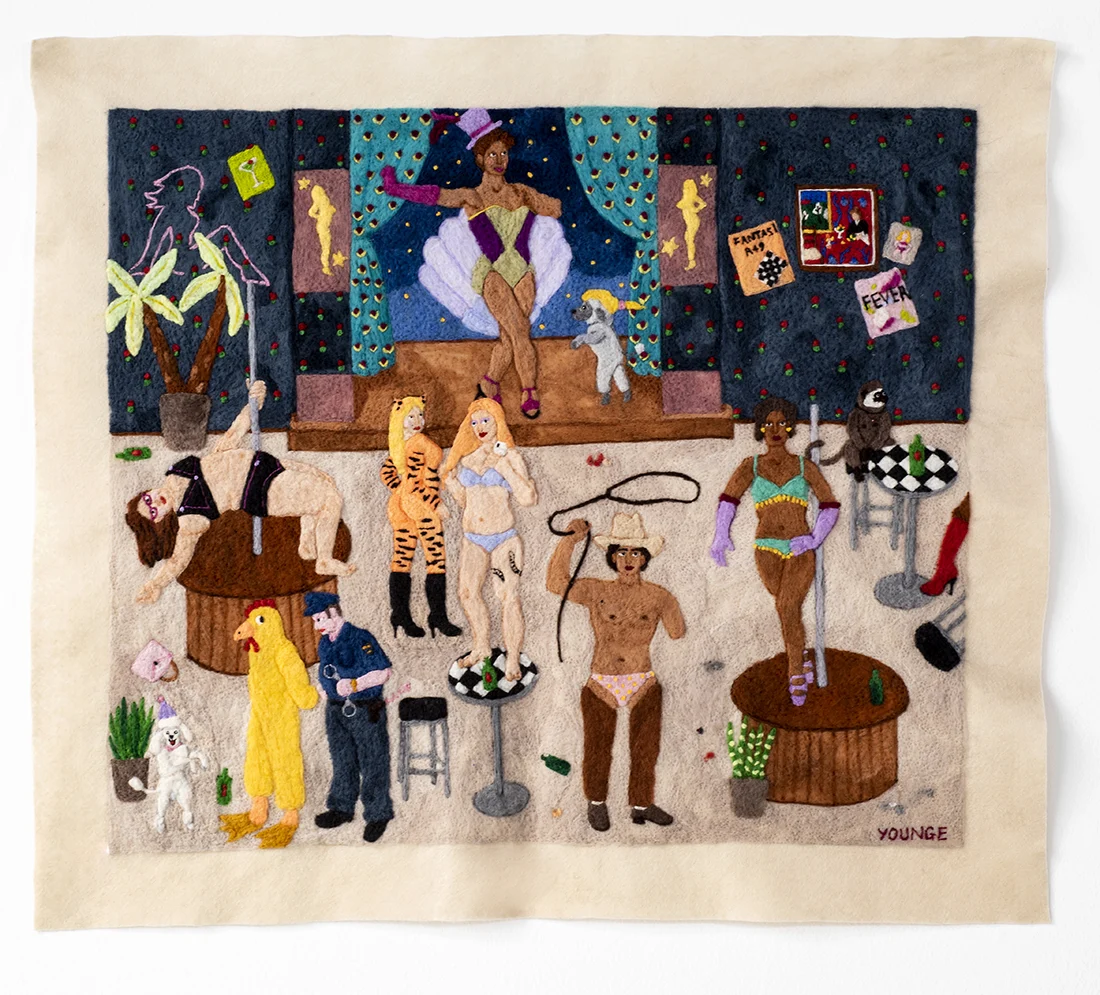
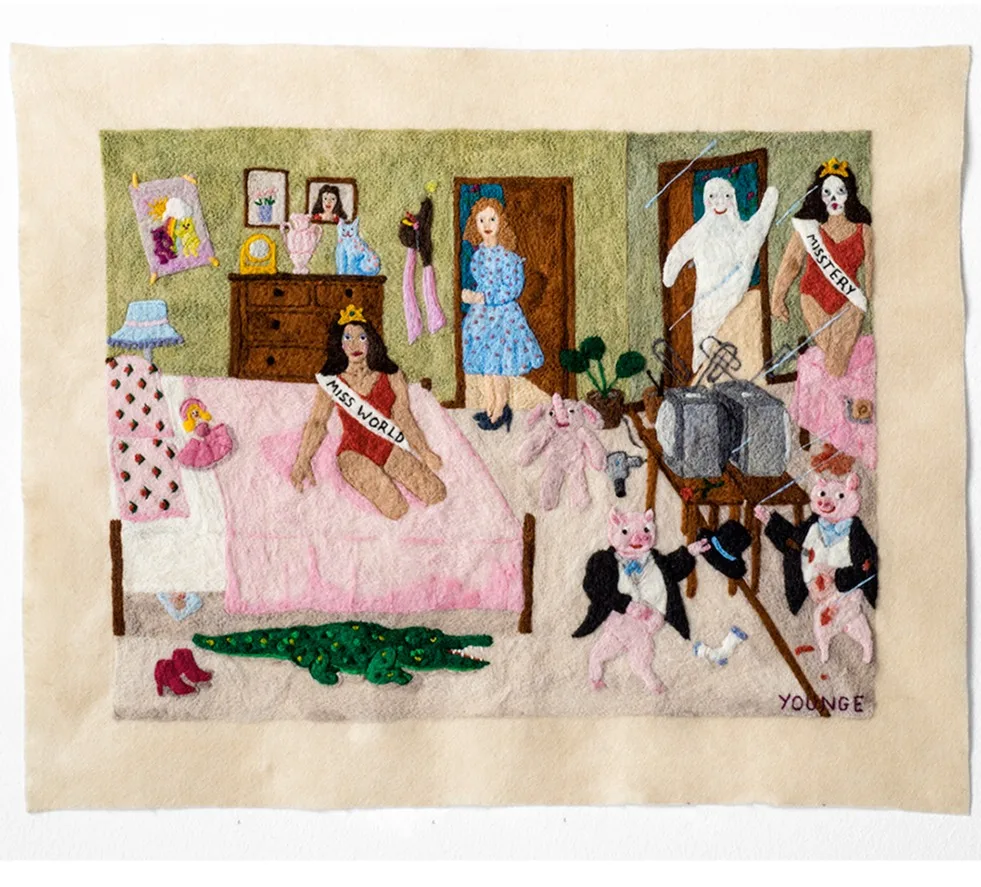
We grew up watching cartoons where animals would hit each other with anvils.
“I think a lot of things in our world are more violent than they appear or than we realize. We grew up watching cartoons where animals would hit each other with anvils or drive over each other in cars, but it’s seen as alright because it’s ‘not real.’ I think people have inherently violent sides to them that they mostly keep locked away, but it’s ingrained into our culture,” Michaela says.
The violence in these little woolen scenes might shock some viewers at first, but as much as her work acknowledges the ever-present violence and hardship in the world, it also offers a great way to deal with the sheer weight of it all: humor. “I think South Africans often approach things with humor,” she says. “That’s our way of dealing with a fucked up world.”
“The risotto with scallops is where hope goes to die” - JR (2018)
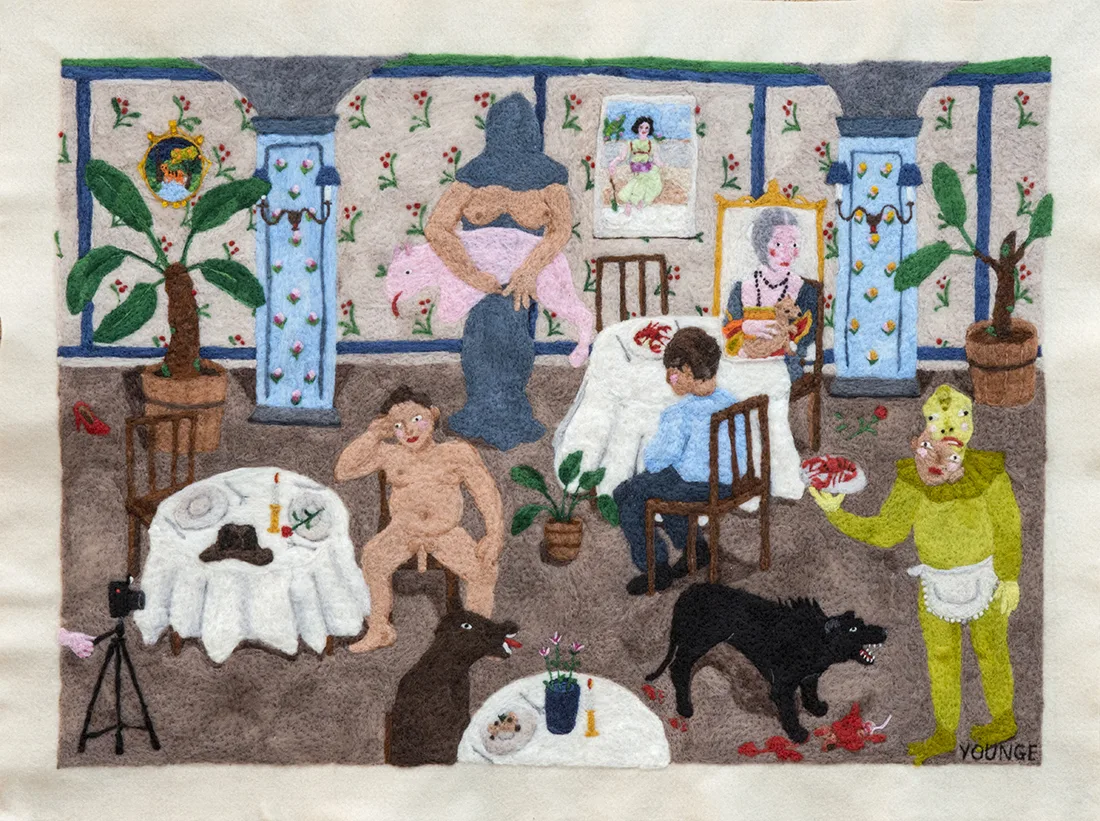
“This older piece depicts a scene in a restaurant. There’s floral wallpaper and molding on the walls, so you can tell it’s a fancy place. On the left side of the work, a naked man sits alone at the table. His hat and a single red rose sit before him, while the two plates remain empty. He seems to have been stood up, as he looks down towards the rose sadly. At another table, a donkey sits alone eating the scallop risotto. A black dog with its teeth bared growls and barks at the only waiter. The waiter seems to have been wearing a human face or mask that has fallen down, revealing their true being underneath, startling the dog. At the last table, a small boy sits dejectedly with a reproduction of Da Vinci’s Lady with an Ermine from 1489. A lobster sits in front of an empty chair, signaling someone has left the table.”
Apple juice, blanchisseuse, chicken mousse, mother goose, drug abuse, a flag of truce (2020)

“In this piece, a car has crashed into the window of a convenience store, knocking over a shelf of organic, gluten-free red wines. None of the other shop-goers appear to have noticed, including a man whose arm has been severed, leaving a bloody, open wound. There’s a charity collection box in the shape of a small girl with a bear that was in every Pick n Pay growing up. Near the cashier is a frog with a gun holster, holding a shopping
basket. I imagine it’s his car and he crashed because he can’t drive well because he’s a frog. The cashier was on the phone, but he appears to be distracted by something, and there’s a Valentine’s Day display advertising bears with hearts and bottles of alcohol. It’s very romantic.”
Fervour and Weakness Go Hand in Hand (2020)
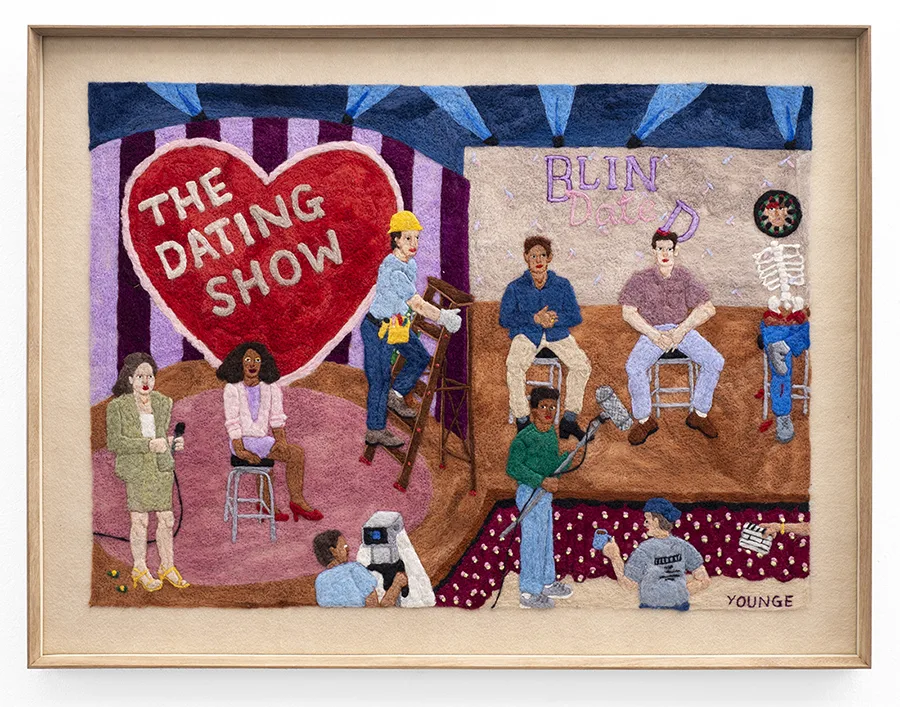
“This one shows various contestants on The Dating Show. A woman in a lilac dress sits on a bar stool next to the host of the show, who is holding a microphone. The three men she’s choosing between sit nervously on the other side of the stage. The last contestant has been made into a bullseye on a dart board. His face is stuck on the board, while his body turns into a skeleton. I’m not sure what happened exactly but perhaps it was caused by a jilted lover or a magic trick gone wrong. In the work, you can see the people ‘behind the scenes,’ including the director and the sound person. A sexy handyman climbs a ladder on the set, with a yellow hard hat and a yellow tool belt.”
The House America Was Talking About (2020)
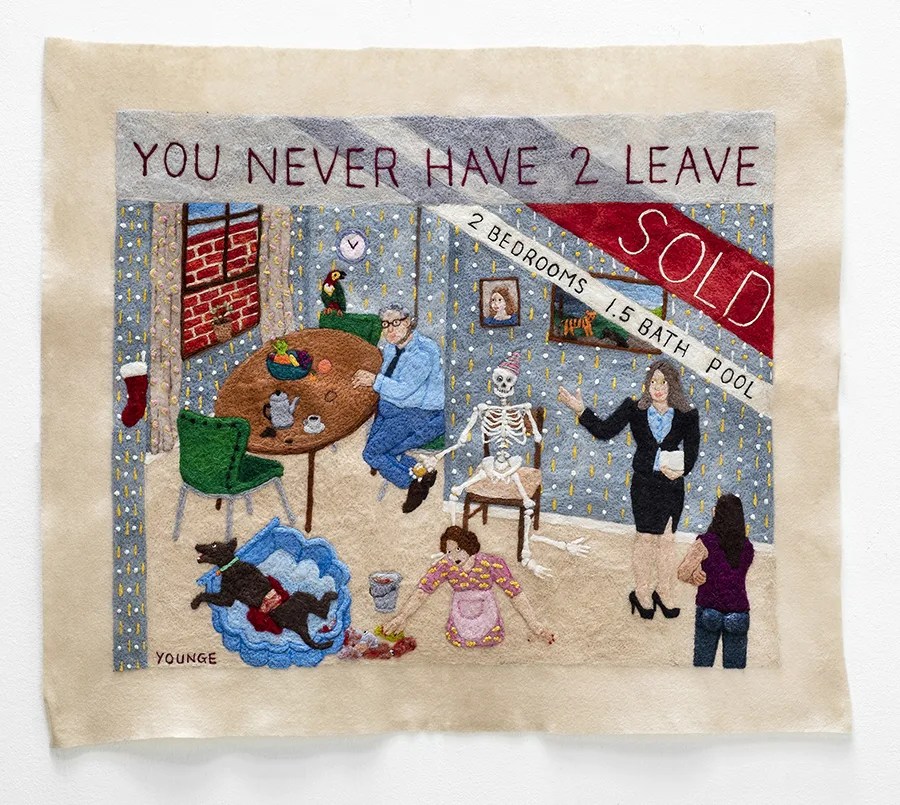
“The previous residents of the home are in the dining room, while in the bottom right a real estate agent does a sales pitch to a potential new buyer. The words ‘You Never Have 2 Leave’ are echoed by a skeleton that sits perched upright in a chair. At the dining room table, a light breakfast is set out with fruit and coffee, the mark of a previous cup stains the table, and a man hangs himself from a noose at the chair. A banner across the right hand side of the work indicates that the house offers two bedrooms, 1.5 bathrooms and a pool, but it’s a broken promise. The pool is just a blue, plastic kiddies pool, and it’s already occupied by the family dog who’s bleeding out from a wound, while a woman cleans the floor next to it. The window, while big, shows a view of a brick wall. You don’t just have the right to stay; you’re trapped. The House America Was Talking About is an undelivered promise. The dog has died, but at least the wallpaper is perfect.”

